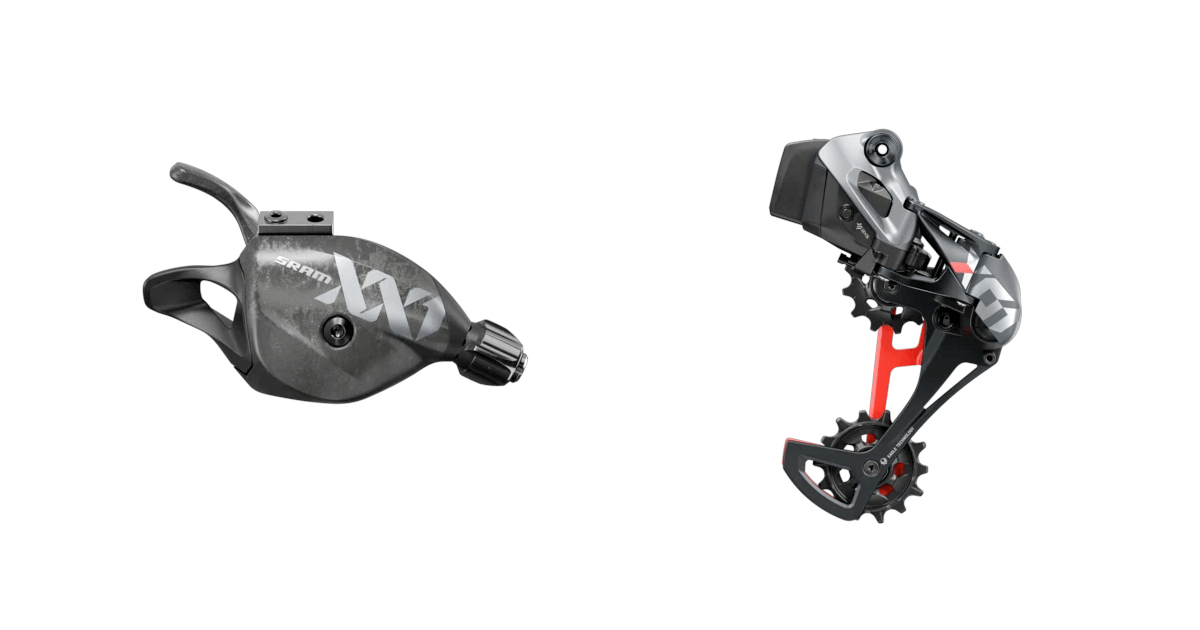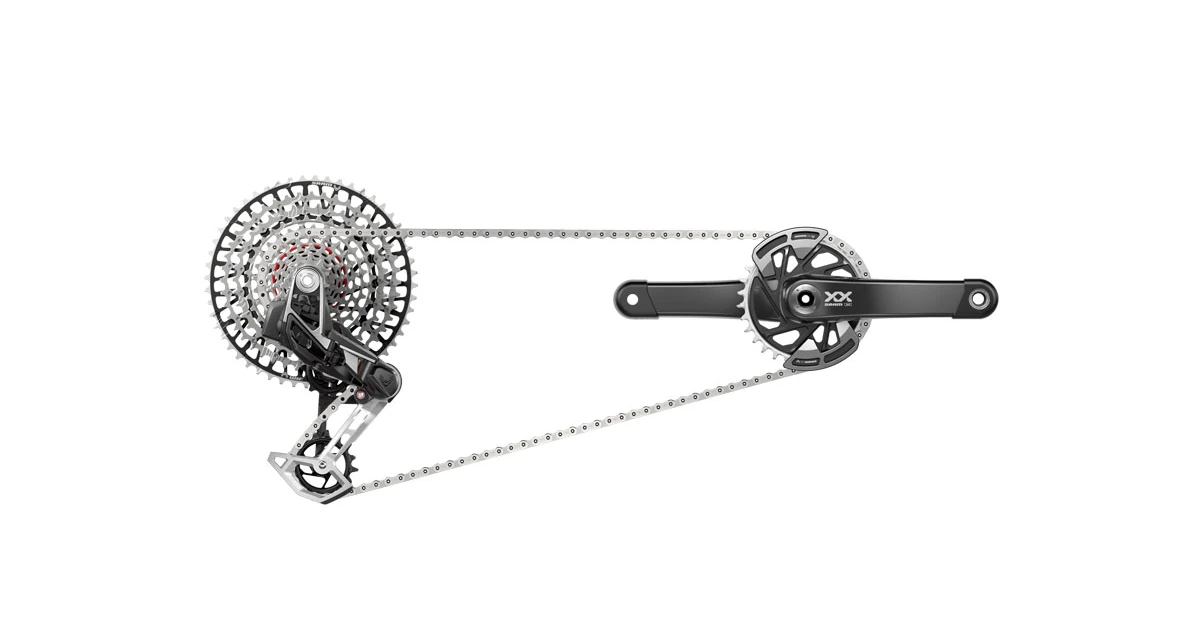Overview and Specifications of WheelTop's Affordable Electronic Groupset "EDS"
This article summarizes the features and specifications of the budget-friendly electronic groupset "EDS" newly released by the Chinese manufacturer WheelTop.
Modified at: Mar 28, 2025
Posted at: Mar 20, 2023
This section summarizes the grades, features, and compatibility of SRAM's Eagle series of components for MTB, as well as the electric component AXS and the latest component, Eagle Transmission.

Table of contents
Sponsored Link

Compatibility Guide for SRAM MTB Components
A detailed explanation of compatibility between SRAM MTB components. This guide outlines which parts can be used together and which combinations are not compatible.
SRAM’s MTB components were once structured under series like XX, X.0, X.9, X.7, X-5, X.4, and X.3. However, with the launch of the XX1 Eagle in 2016, the entire MTB lineup was rebranded under the “Eagle Collection.”
As a result, all current SRAM MTB components now carry the Eagle name and are 12-speed, front-single drivetrain systems.
The Eagle Collection is divided into five tiers, ranging from the top-end XX1 (optimized for cross-country) and X01 (for enduro) to the entry-level SX. The top three tiers—XX1, X01, and GX—also offer AXS, SRAM’s wireless electronic shifting system.
AXS corresponds to the eTap AXS in SRAM’s road component lineup. The lower-end models, NX Eagle and SX Eagle (commonly found on budget complete bikes), do not feature wireless shifting options.
| Series | Target Use | Speeds |
|---|---|---|
| XX1 Eagle AXS | Cross-country | 12-speed |
| XX1 Eagle | Cross-country | 12-speed |
| X01 Eagle AXS | Enduro | 12-speed |
| X01 Eagle | Enduro | 12-speed |
| GX Eagle AXS | Mid-grade | 12-speed |
| GX Eagle | Mid-grade | 12-speed |
| NX Eagle | Entry-level | 12-speed |
| SX Eagle | Entry-level | 12-speed |
All SRAM Eagle series MTB drivetrains follow a “1x12” configuration, meaning a single front chainring and a 12-speed rear cassette. This setup delivers the modern MTB trend of a wide gear range with simplified shifting, regardless of grade.
The SX Eagle is especially popular on entry-level MTB complete bikes, as it brings 12-speed performance to budget-friendly setups.
Meanwhile, high-end MTB bikes are increasingly offered with Eagle AXS groupsets, giving buyers a choice between SRAM AXS and Shimano Di2 for their wireless shifting preferences.
On March 22, 2023, SRAM launched a new generation of MTB wireless drivetrain systems under the name Eagle Transmission.
Eagle Transmission introduced several key upgrades, including:
At launch, only wireless (electronic) shifting models were available. However, in March 2025, SRAM added mechanical drivetrain options named EAGLE 90 and EAGLE 70, expanding the lineup.
The Eagle Transmission tiers include:
Importantly, Eagle Transmission components (such as cassette and chain) are not compatible with previous Eagle drivetrains. These are dedicated, Transmission-specific parts.
| Series | Target Use | Shifting | Speeds |
|---|---|---|---|
| XX SL Eagle AXS Transmission | Cross-country | Wireless | 12-speed |
| XX Eagle AXS Transmission | Enduro | Wireless | 12-speed |
| X0 Eagle AXS Transmission | Mid-grade | Wireless | 12-speed |
| GX Eagle AXS Transmission | Mid-grade | Wireless | 12-speed |
| EAGLE 90 Transmission | Top-grade | Mechanical | 12-speed |
| EAGLE 70 Transmission | Mid-grade | Mechanical | 12-speed |
While electronic and mechanical shifting components cannot be mixed (e.g., derailleur and shifter), other drivetrain components like the crankset, chain, and cassette can be shared across all Eagle Transmission models, regardless of shifting type.
Apart from the main component series, SRAM has a dedicated brake series lineup.
These are only available with braking systems and no drivetrain components such as shifters or crankshafts.
Until the March 2025 rebranding, SRAM’s MTB brake range included four distinct series based on braking characteristics:
Each of these included both brake levers and disc brake calipers, catering to different riding styles and needs.
In March 2025, SRAM overhauled its MTB brake lineup, consolidating it into three core series under a new branding scheme:
One of the biggest changes with the new brake series is the switch from DOT brake fluid (used in SRAM’s legacy systems) to mineral oil — a fluid type also used by Shimano and favored for its longevity and ease of maintenance.
This update reflects SRAM’s move toward greater reliability, environmental friendliness, and compatibility with industry-standard maintenance practices.
Sponsored Link
Shimano MTB Component Grades and Compatibility
The following is a list of Shimano MTB component grades and model numbers. Also includes compatibility with components for road and gravel bikes.
Wire Types and Differences for Road Bikes, MTB, and Hybrid Bikes
This is a summary of the types and differences of wires for MTB and hybrid bikes for road bikes. The interchangeability of each, and how the wires affect your riding.
Choosing a Rear Derailleur for Road, MTB, or Hybrid Bikes
How to choose a new rear derailleur for your road bike, MTB, or hybrid bikes, what to look for in a combination of sprockets, and the differences between different grades.
SENSAH's components for MTB and gravel
This is a summary of Chinese bicycle parts manufacturer SENSAH's components for MTB and gravel. It also includes the equivalent Shimano componentry grade and compatibility with Shimano parts.
Q Factor: Measurement, Determination, and Adjustment
Q-factor is an important factor for improving pedaling efficiency. we summarize what Q-factor is, how to measure it, how to determine the proper value, and how to adjust it.
Gear Ratios: Cross, Wide, and the Deep World
Cross ratios, wide ratios, the world of gear ratios is a deep one. We will take a look at the advantages and disadvantages of changing the number of teeth on the sprocket, and the combination with the chainring.
Summary of electric components for MTB
This section summarizes the types of electric components for MTB and the advantages and disadvantages of each.
MTB Dropper Seatposts: Types and Considerations
The dropper seat post is becoming a "must-have" part for MTB. Here we summarize the lineup, specifications, and features of dropper seatposts for MTB from major manufacturers, as well as a comparison of each manufacturer and points to consider when choosing a dropper seatpost.
Shimano Mechanical Brake Levers for MTB and Hybrid Bike
Shimano mechanical brake levers are now few and far between. The following is a summary of the current model lineup, specifications, and compatible components.
SRAM Component Grades and Compatibility Summary for MTB
This section summarizes the grades, features, and compatibility of SRAM's Eagle series of components for MTB, as well as the electric component AXS and the latest component, Eagle Transmission.
Choosing a Road Bike Frame for Shimano Di2
Shimano's Di2 electric shifter is attractive for its lightweight parts and reliable shifting.In order to convert to Di2, not only do you need to purchase Di2 parts, but also your road bike frame needs to be Di2 compatible.
Shimano Road Bike Component Compatibility Summary
Compatibility of Shimano Components for Road Bikesa Shimano components for road bikes tend to be confusing with various parts in different grades and generations. In this article, we summarize the compatibility trends of Shimano components.
Shimano road disc brake component compatibility summary
Shimano disc brake components for road use are difficult to select if you don't know about them. We have compiled a list of parts model numbers and their incompatibility, which can be difficult to understand.
Shimano's GRX Gravel Bike Components and Features
The following is a summary of Shimano's GRX lineup of components for gravel bikes, its features, and the advantages and disadvantages of choosing GRX.
SRAM Component Grades and Compatibility Summary for MTB
This section summarizes the grades, features, and compatibility of SRAM's Eagle series of components for MTB, as well as the electric component AXS and the latest component, Eagle Transmission.
Summary of electric components for MTB
This section summarizes the types of electric components for MTB and the advantages and disadvantages of each.
Overview and Specifications of WheelTop's Affordable Electronic Groupset "EDS"
This article summarizes the features and specifications of the budget-friendly electronic groupset "EDS" newly released by the Chinese manufacturer WheelTop.
What Is Shimano Shadow RD? Features and Benefits
What is Shimano’s Shadow RD used in their latest rear derailleurs? This article explains its features and the benefits of choosing Shadow RD.
[MTB / Hybrid Bike] Hydraulic Brake Manufacturers for Flat Bars
An overview of manufacturers that produce hydraulic brakes for flat-bar MTB and hybrid bikes, along with their key features. Also includes tips on how to choose the right flat-bar hydraulic brake brand.
Shimano Chain Compatibility for Road, MTB, and Hybrid Bikes
An overview of Shimano chain compatibility across road bikes, mountain bikes, and hybrid bikes. Includes guidance on how to choose the right chain for your drivetrain.
Shimano ESSA Lineup and Compatibility with Existing 8-Speed Parts
An overview of Shimano's newly released 8-speed component group "ESSA" and its compatibility with existing 8-speed parts.
SRAM Cassette Compatibility Guide
Compatibility guide for SRAM cassettes used in road and MTB bikes. Find matching drivetrains and wheels easily.
Compatibility Guide for SRAM MTB Components
A detailed explanation of compatibility between SRAM MTB components. This guide outlines which parts can be used together and which combinations are not compatible.
Road and MTB Sprockets Compatibility Overview
A guide to the compatibility between road and MTB sprockets, explaining whether they can be used together with different components.
Types of Shimano Di2 Tools and Their Compatibility
A guide to the essential Shimano Di2-specific tools, especially the "plug tools" used for connecting components, and their compatibility with various Di2 parts.
Shimano CUES Cassette Compatibility Guide
A detailed guide to the compatibility of Shimano CUES series cassettes. Includes an overview of compatible rear derailleurs, chains, and wheels.
Shimano Hydraulic Brake Hose and Connector Standards Guide
An explanation of the differences between Shimano’s hydraulic brake hoses BH90 and BH59, the types of connecting bolts, and how to choose the right hose for your brake system—including key points to watch out for.
[By Manufacturer] Types, Features, Pros and Cons of Hydraulic Brake Oils
This article explains the types of hydraulic oils used in bicycle hydraulic brakes, their characteristics, and the brake oil types used by each manufacturer.
Types and Compatibility of Shimano Di2 Batteries
The Di2 battery is the core of the Shimano Di2 system, influencing the overall system layout. This article explains the different types and their compatibility.
Shimano Di2 Wire Types and Compatibility
Overview of Shimano Di2 electric wire types and their compatibility with Di2 components.
How to Identify Shimano Di2 Generations
Explains the generational differences in Shimano Di2 components and their compatibility. Includes a list of component series and their corresponding generations.
In-Depth Guide to Shimano 12-Speed Cassette Compatibility
A detailed explanation of the key compatibility factors when using Shimano's 12-speed cassettes—specifically the required wheel (freehub) and drivetrain, which differ significantly from previous 11-speed systems.
Perfect Guide to Shimano 11-Speed Cassette Compatibility
A detailed explanation of two key compatibility factors when using Shimano 11-speed cassettes: the required wheel (freehub) and drivetrain.
Perfect Guide to Shimano 10-Speed Cassette Compatibility
A detailed explanation of two key compatibility factors when using Shimano 10-speed cassettes: the required wheel (freehub) and drivetrain.
In-Depth Guide to Shimano 9-Speed Cassette Compatibility
A comprehensive explanation of two key compatibility factors when using Shimano 9-speed cassettes: the required wheel (freehub) and drivetrain.
What Is a BOOST Crank? Differences from Standard MTB Cranks and How to Choose
This article explains what a BOOST crank is, how it differs from conventional MTB cranks, and provides guidance on selection across different manufacturers.